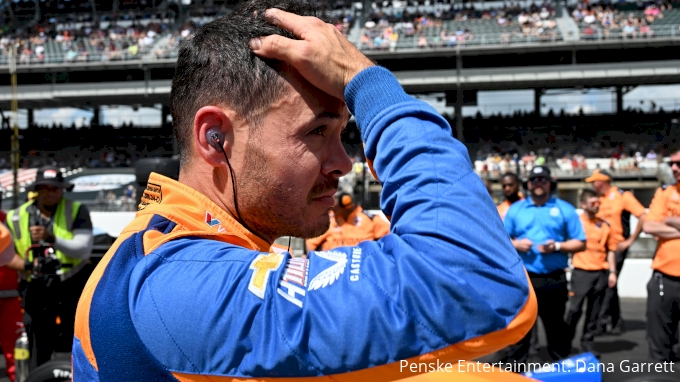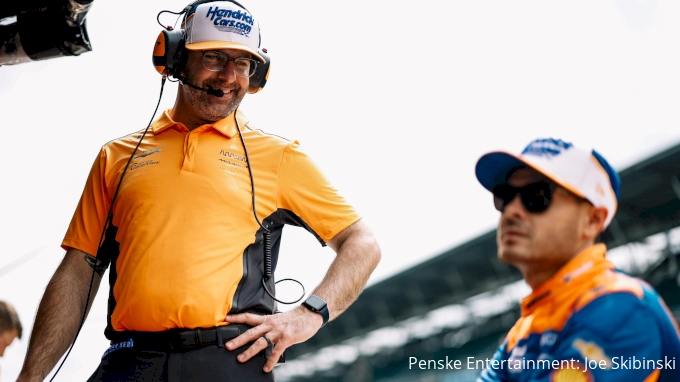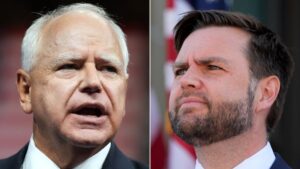Takeaways From Kyle Larson’s Indy 500 Debut: ‘We Had A Legitimate Shot’

If only Kyle Larson could relive two fleeting moments from Sunday’s latest Indianapolis 500 barnburner that slipped through his grasp.
Of course, his 18th-place finish will stand for the rest of time as his official result of a touted debut that’s been many years in the making. But what if he could get the moment back during the 108th running of The Greatest Spectacle in Racing where he unintentionally missed second gear on the race’s first restart? The moment that swiftly freight-trained him down the leaderboard from sixth to 14th nine laps into the 200-lap running.
And the lap-130 pit road speeding infraction? If only he knew he didn’t have to charge the commitment line as hard as he did to remain in reach of the Borg-Warner Trophy. But Larson’s only two blemishes of an otherwise stouthearted day — a day he rallied from the missed shift back into the top-five and then rallied again from the pit road penalty thanks to strategy to lead laps 180-184 — are faults that strategist Brian Campe can’t nitpick.
Larson was always going to push his dynamic self to the brink. It’s what Campe encouraged him to do all along.
“He was just trying to get all he can get, which is what you want him to do,” Campe told FloRacing in a phone interview following the race because the strategist, along with Larson, booked it out of Indianapolis Motor Speedway to catch a flight to Charlotte. “I’m not at all disappointed in that. We’re going to learn from the experience and put it in the bank for next time.”
Before Larson had anything to say about his eventful Indy 500 debut, he, too, instantly skipped ahead toward the redemptive thought of giving the 109th installment of the world’s biggest race a go. Perhaps a taste of what it could be like without the two setbacks excites him all the more.

Kyle Larson at the Indianapolis 500. (Dana Garrett)
“I would definitely love to be back next year,” Larson told NBC’s Marty Snider in a short postrace interview before jetting out of Indianapolis toward Charlotte so he could try and catch the last half of the eventually rain-shortened Coca-Cola 600 he never participated in. “I feel like I learned throughout the race. I made a couple mistakes early there with the restart.
“Somehow got myself to third (gear). I felt like I did a really good job on the restarts and was able to learn a lot. Definitely feel good about knowing what I’d need different for the balance when coming back to help run some stuff.
“Then, obviously, smoked the left-front or something in that green-flag stop and killed our opportunity. Proud to finish, but pretty upset at myself. If I could’ve just executed a better race, you never know what could’ve happened.”
Despite the two momentum killers, Larson still found himself in position to dream while leading for four laps. Because the lap-130 pit road speeding penalty foiled his best chances at the Indy 500 win, the Larson had to resort to an offbeat strategy during a lap-153 caution to keep any glimmer of hope alive.
Making it 47 straight laps to the finish was never going to work — drivers can only make it 28-34 laps on a tank of fuel at the 2.5-mile oval — but Campe and team still tried the last-resort strategy because wilder things have happened before. Also, if enough cautions fell and if Larson could save enough fuel, there was the smallest chance he could stretch the tank of fuel for 47 laps to the finish.
“It was our only chance because you don’t get a chance to win the Indy 500 everyday,” Campe said. “We took it and he did a good job of saving fuel. It just got away from us. We still needed cautions even at the number I was giving him. But we took a swing at it, right? If you’re on the lead lap and can take a swing, that’s all you can ask for. If you stop the race right before the speeding penalty and evaluate our performance, I think we’re in the conversation.”
Campe doesn’t know how much Larson exceeded pit road’s speed limit. What he does know is that Larson would’ve cycled around to fourth, most likely, if not for the infraction, right behind eventual winner Josef Newgarden, Scott McLaughlin and teammate Alexander Rossi.
“Up until that point, we had a legitimate shot,” Campe said. “Even after the speeding penalty Kyle did a great job, the team did a great job addressing what’s in front of us (to) cut some laps to get to where we needed to get. When the caution fell, we were right in position to get the wave around to put us back on the lead lap. When you’re on the lead lap, you have a shot.”
Until Larson inherited the lead on lap 180, Campe had stressed the importance to save as much fuel as possible. But once Larson got out into open track, there wasn’t an opportunity to save fuel anymore. At that point, for those next four laps, Campe prayed for a caution to fall their way so they could leverage the track position without having to relinquish it.
“We needed a caution right then with him in the lead,” Campe said. “We needed a caution, and then maybe everyone would’ve pitted and it would’ve worked out. We tried.”

Race strategist Brian Campe (left) with Kyle Larson (right). (Joe Skibinski)
Campe said that Larson could’ve stretched it out through lap 186 or even 187, but they “didn’t want to interfere with our (Arrow McLaren) teammates,” eventual runner-up Pato O’Ward and Rossi, who gave Newgarden all he handle down the stretch.
“They outright had the speed and outright had the strategy,” Campe said of O’Ward and Rossi. “No, I didn’t get Kyle’s vote on it, but on the stand we discussed and (knew) we didn’t have a shot to win it on fuel. We didn’t want to accidentally run it out of fuel or put him in a compromising position on old tires that our teammates didn’t need.”
“At that point, we were trying to be a good steward to our teammates and pit behind them so we didn’t interfere with the race to the win. We just wanted to end our day with one last run and complete all the laps.”
Completing all 200 laps and enduring two setbacks that Larson couldn’t effectively prepare for will surely do wonders for him when he’s expected to return for another Indy 500 go-around next May. Larson’s missed shift — when he accidentally hit the paddle shifter twice on the lap-nine restart and jumped from first to third gear — came on his first-ever IndyCar restart.
One of the few race-like situations he could never practice during formal practice sessions are, indeed, restarts. Larson, however, executed all remaining seven restarts without issue. Then while Larson did simulate green flag stops during last Monday’s and Friday’s practice, they weren’t comparable to the pressures he faced in Sunday’s high-stakes environment.
If that’s all that went wrong for Larson, how could anyone be truly upset? Campe isn’t. His case has been made to reassemble the Chevy-Dallara-powered No. 17 Hendrickcars.com Arrow McLaren team again when they’re expected to run it back next year.
“Yeah, absolutely. I wouldn’t trade anybody for anything,” Campe said. “Everybody punched above their weight and punched above expectations the entire experience. I think that’s a testament to everybody involved. Not everybody does it full-time. Some guys came over from the Formula 1 team and that just shows the depth that McLaren has and Chevrolet, and everybody involved.
“I don’t know all the details. But if we’re coming back, I’d be happy to jump on a plane do it again.”





